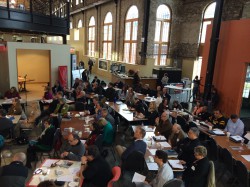Historic Preservation Goes Crazy
Bigger state tax credits have tripled applications for historic preservation projects, which is great news for Milwaukee.
Architects, developers and economic development officials gathered at Zimmerman Architectural Studios in the Menomonee Valley to learn about the state’s new historic preservation tax credit program. Under the revamped program, the state will award a 20 percent tax credit to qualifying projects that can be paired with a 20 percent federal tax credit. With bi-partisan support, the tax credit has been increased twice in the past year, going from five to ten percent in the latest state budget, and now rising to 20 percent in separate legislation. The last increase has already tripled the number of applications for the credit, according to the Wisconsin Historical Society’s Jim Draeger, whose agency manages the application process.
Draeger, along with Gorman & Co.’s Ted Matkom, Jonathan Beck of Alexander Co. of Madison, and Wayman Lawrence, a partner at Foley & Lardner, served on a panel that collectively explained how to execute a historic preservation tax credit program. The panel was moderated by Matt Jarosz, Director of the UW-Milwaukee Historic Preservation Institute, which was the event host along with the Milwaukee Preservation Alliance.
According to Draeger’s presentation, in 2012 $5.33 billion in historic preservation tax credit deals took place nationwide. With the average project costing $5.23 million and creating 78 jobs, 57,000 jobs were created nationwide. In Wisconsin, under the five percent tax credit (plus 20 percent federal) $84.5 million worth of historic preservation credit deals took place. In January 2014, the first month in which the increased credit was available, the state received $90 million worth of applications. Draeger stressed that this isn’t a program to create museums, it’s about adaptive reuse (an example of how Wausau converted a former courthouse into an apartment building was given). Using an example from a project in Green Bay, Draeger demonstrated that it is often cheaper to rehab an existing building than build a new one.
Lawrence walked through all the tax implications of the credits, and what they can be sold for. For brevity’s sake and because I’m not a lawyer, I’ve included a scanned copy of his presentation. Suffice to say, you can’t sell a $1 million tax credit for $1 million; you end up with less. How much less depends on a number of variables.
A lively question and answer session ended the event, with examples of how non-profits could take advantage of the program and details on a much simpler tax credit program for individual home-owners.
Long-Term Effect
The surge in applications reported by Draeger is evidence that the future for historic buildings in Wisconsin is much brighter. A local example is the Button Block building: the building has been on the market for years, but it recently sold to Bear Development. Bear plans to keep Joey Buona’s restaurant and add apartments to the upper floors, likely utilizing the increased tax credits.
Increasing the available capital for adaptive reuse projects via the tax credits is a decidedly pro-city move by Republican Gov. Scott Walker and the legislature. It will activate a number of under-utilized buildings in urban neighborhoods, and save a lot of buildings from the wrecking ball. The result is likely to be an increase in the number of walkable and exciting neighborhoods in Milwaukee.
Eyes on Milwaukee
-
Church, Cupid Partner On Affordable Housing
 Dec 4th, 2023 by Jeramey Jannene
Dec 4th, 2023 by Jeramey Jannene
-
Downtown Building Sells For Nearly Twice Its Assessed Value
 Nov 12th, 2023 by Jeramey Jannene
Nov 12th, 2023 by Jeramey Jannene
-
Immigration Office Moving To 310W Building
 Oct 25th, 2023 by Jeramey Jannene
Oct 25th, 2023 by Jeramey Jannene


















so, let me get this straight. the tax credit benefits the developers of historic properties. does this mean their considerable savings will be passed on to prospective renters? rents need to be affordable, or there will be nobody walking in our preserved neighborhoods.
Judith, rents/product price are set at what the market will pay… have you ever heard a landlord say “well, my costs for this unit are $400/month, I’ll charge $450”?
No, if they think they can get $700/month, that’s the rent.
The biggest problems with affordability in a city like Milwaukee, come from people not having enough income, not from the real estate being too expensive. Let’s put people to work rehabbing buildings and let’s increase the tax base of our communities. Being afraid of change doesn’t help anything here.
The essential point of the historic tax credit(s) (Wisconsin has several types such as income-producing, residential, and non-designated pre-1936 buildings) is to offset the cost of sympathetically restoring historic buildings to ensure that they stay part of our urban fabric. New construction cannot afford the detailing we see in historic buildings. Undertaking a restoration and replacing like materials with like to ensure they remain “historic” simply takes more dollars to accomplish. These tax credits have been studied for years and reports are issued by the National Park Service each year documenting how many jobs they create and how they spur urban redevelopment. There is nothing more “Green” or “Sustainable” than restoring a building that is already here; these tax credits bring in that project at a more palatable cost.
judith ann moriarty is on the right track. Historic preservation tax credits help cities architecturally and economically, but not necessrily people looking for decent, affordable housing. But there are programs that do help tenants AND prserve older buildings. The federal government has a pot of money for affordable housing tax credits which are awarded every year in competition. Wisconsin’s pot is administered by the state housing and economic development authority. Developers win tax credits for new or redeveloped projects that are all housing or mixed-use projects including housing. In exchange for the tax credits, developers agree that for 30 years they’ll reserve at least 20% of the rental units for households with income less than half the county median income, or at least 40% of the units for households with income less than 60% of CMI. Some fine federally subsidized, quality rental housing has been developed across this state using this program, much of it in Milwaukee. But the tax credit allocation for Wisconsin is modest, lately running around $12 million a year. In Milwaukee an example of this program is the 700 Lofts project (a downtown building that features Joey Buono’s restaurant on the first floor).
Right has a good point, but he is merging two projects into one. The 700 Lofts on 7th and Michigan will rehab an existing, but not historic building. The Joey Buona’s project (Button Block Building) will likely make use of Historic Preservation Tax Credits. Both are by Bear Development.
As the legendary Jane Jacobs states, you want a supply of buildings of all ages in the market to ensure diversity of uses and prices at all levels. By increasing the tax credit programs, you increase supply at the high end (as new units are almost higher end than the oldest stuff on the market). That reduces price increases (by reducing demand) on the low end. Yes, some of the affordable buildings are the old, historic buildings, but there are lots of buildings not in productive use that are excellent candidates for historic rehabs (Button Block, Germania).